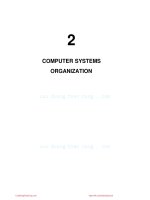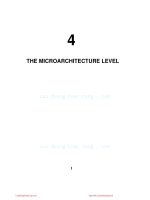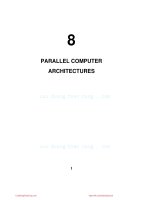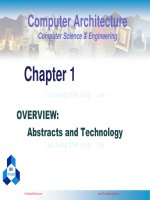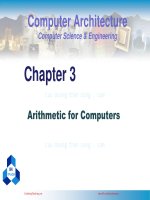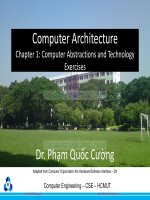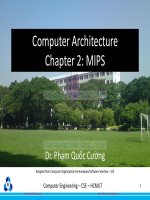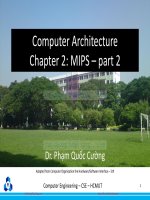kiến trúc máy tính phạm minh cường chương ter3 arithmetic for computers sinhvienzone com
Bạn đang xem bản rút gọn của tài liệu. Xem và tải ngay bản đầy đủ của tài liệu tại đây (2.28 MB, 56 trang )
Computer Architecture
Chapter 3: Arithmetic for Computers
Dr. Phạm Quốc Cường
Adapted from Computer Organization the Hardware/Software Interface – 5th
Computer Engineering – CSE – HCMUT
CuuDuongThanCong.com
/>
1
Arithmetic for Computers
• Operations on integers
– Addition and subtraction
– Multiplication and division
– Dealing with overflow
• Floating-point real numbers
– Representation and operations
CuuDuongThanCong.com
Chapter 3: Computer Arithmetic - Dr. Cuong
Pham-Quoc
2
/>
Integer Addition
• Example: 7 + 6
• Overflow if result out of range
– Adding +ve and –ve operands, no overflow
– Adding two +ve operands
• Overflow if result sign is 1
– Adding two –ve operands
• Overflow if result sign is 0
CuuDuongThanCong.com
Chapter 3: Computer Arithmetic - Dr. Cuong
Pham-Quoc
3
/>
Integer Subtraction
• Add negation of second operand
• Example: 7 – 6 = 7 + (–6)
+7:
–6:
+1:
0000 0000 … 0000 0111
1111 1111 … 1111 1010
0000 0000 … 0000 0001
• Overflow if result out of range
– Subtracting two +ve or two –ve operands, no overflow
– Subtracting +ve from –ve operand
• Overflow if result sign is 0
– Subtracting –ve from +ve operand
• Overflow if result sign is 1
CuuDuongThanCong.com
Chapter 3: Computer Arithmetic - Dr. Cuong
Pham-Quoc
4
/>
Dealing with Overflow
• Some languages (e.g., C) ignore overflow
– Use MIPS addu, addui, subu instructions
• Other languages (e.g., Ada, Fortran) require
raising an exception
– Use MIPS add, addi, sub instructions
– On overflow, invoke exception handler
• Save PC in exception program counter (EPC) register
• Jump to predefined handler address
• mfc0 (move from coprocessor reg) instruction can
retrieve EPC value, to return after corrective action
CuuDuongThanCong.com
Chapter 3: Computer Arithmetic - Dr. Cuong
Pham-Quoc
5
/>
Arithmetic for Multimedia
• Graphics and media processing operates on
vectors of 8-bit and 16-bit data
– Use 64-bit adder, with partitioned carry chain
• Operate on 8×8-bit, 4×16-bit, or 2×32-bit vectors
– SIMD (single-instruction, multiple-data)
• Saturating operations
– On overflow, result is largest representable value
• c.f. 2s-complement modulo arithmetic
– E.g., clipping in audio, saturation in video
CuuDuongThanCong.com
Chapter 3: Computer Arithmetic - Dr. Cuong
Pham-Quoc
6
/>
Multiplication
• Start with long-multiplication approach
multiplicand
multiplier
product
1000
× 1001
1000
0000
0000
1000
1001000
Length of product is
the sum of operand
lengths
CuuDuongThanCong.com
Chapter 3: Computer Arithmetic - Dr. Cuong
Pham-Quoc
7
/>
Multiplication Hardware
Initially 0
CuuDuongThanCong.com
Chapter 3: Computer Arithmetic - Dr. Cuong
Pham-Quoc
8
/>
Example
• Using 4-bit numbers, multiply 210x310
CuuDuongThanCong.com
Chapter 3: Computer Arithmetic - Dr. Cuong
Pham-Quoc
9
/>
Optimized Multiplier
• Perform steps in parallel: add/shift
• One cycle per partial-product addition
– That’s ok, if frequency of multiplications is low
CuuDuongThanCong.com
Chapter 3: Computer Arithmetic - Dr. Cuong
Pham-Quoc
10
/>
Faster Multiplier
• Uses multiple adders
– Cost/performance tradeoff
• Can be pipelined
– Several multiplication performed in parallel
CuuDuongThanCong.com
Chapter 3: Computer Arithmetic - Dr. Cuong
Pham-Quoc
11
/>
MIPS Multiplication
• Two 32-bit registers for product
– HI: most-significant 32 bits
– LO: least-significant 32-bits
• Instructions
– mult rs, rt
/
multu rs, rt
• 64-bit product in HI/LO
– mfhi rd
/
mflo rd
• Move from HI/LO to rd
• Can test HI value to see if product overflows 32 bits
– mul rd, rs, rt
• Least-significant 32 bits of product –> rd
CuuDuongThanCong.com
Chapter 3: Computer Arithmetic - Dr. Cuong
Pham-Quoc
12
/>
Division
• Check for 0 divisor
• Long division approach
quotient
– If divisor ≤ dividend bits
dividend
1001
1000 1001010
-1000
divisor
10
101
1010
-1000
10
remainder
n-bit operands yield n-bit
quotient and remainder
CuuDuongThanCong.com
• 1 bit in quotient, subtract
– Otherwise
• 0 bit in quotient, bring down
next dividend bit
• Restoring division
– Do the subtract, and if
remainder goes < 0, add
divisor back
• Signed division
– Divide using absolute values
– Adjust sign of quotient and
remainder as required
Chapter 3: Computer Arithmetic - Dr. Cuong
Pham-Quoc
13
/>
Division Hardware
Initially divisor
in left half
Initially dividend
CuuDuongThanCong.com
Chapter 3: Computer Arithmetic - Dr. Cuong
Pham-Quoc
14
/>
Example
• Using 4-bit numbers, let’s try dividing 710 by 210
CuuDuongThanCong.com
Chapter 3: Computer Arithmetic - Dr. Cuong
Pham-Quoc
15
/>
Optimized Divider
• One cycle per partial-remainder subtraction
• Looks a lot like a multiplier!
– Same hardware can be used for both
Dividend (initially)
Reminder (finally) Quotient (finally)
CuuDuongThanCong.com
Chapter 3: Computer Arithmetic - Dr. Cuong
Pham-Quoc
16
/>
Faster Division
• Can’t use parallel hardware as in multiplier
– Subtraction is conditional on sign of remainder
• Faster dividers (e.g. SRT division, use a backup
table instead of restoring) generate multiple
quotient bits per step
– Still require multiple steps
CuuDuongThanCong.com
Chapter 3: Computer Arithmetic - Dr. Cuong
Pham-Quoc
17
/>
MIPS Division
• Use HI/LO registers for result
– HI: 32-bit remainder
– LO: 32-bit quotient
• Instructions
– div rs, rt / divu rs, rt
– No overflow or divide-by-0 checking
• Software must perform checks if required
– Use mfhi, mflo to access result
CuuDuongThanCong.com
Chapter 3: Computer Arithmetic - Dr. Cuong
Pham-Quoc
18
/>
Floating Point
• Representation for non-integral numbers
– Including very small and very large numbers
• Like scientific notation
– –2.34 × 1056
– +0.002 × 10–4
– +987.02 × 109
normalized
not normalized
• In binary
– ±1.xxxxxxx2 × 2yyyy
• Types float and double in C
CuuDuongThanCong.com
Chapter 3: Computer Arithmetic - Dr. Cuong
Pham-Quoc
19
/>
Floating Point Standard
• Defined by IEEE Std 754-1985
• Developed in response to divergence of
representations
– Portability issues for scientific code
• Now almost universally adopted
• Two representations
– Single precision (32-bit)
– Double precision (64-bit)
CuuDuongThanCong.com
Chapter 3: Computer Arithmetic - Dr. Cuong
Pham-Quoc
20
/>
IEEE Floating-Point Format
• S: sign bit (0 non-negative, 1 negative)
• Normalize significand: 1.0 ≤ |significand| < 2.0
– Always has a leading pre-binary-point 1 bit, so no need to represent it
explicitly (hidden bit)
– Significand is Fraction with the “1.” restored
• Exponent: excess representation: actual exponent + Bias
– Ensures exponent is unsigned
– Single: Bias = 127; Double: Bias = 1203
single: 8 bits
double: 11 bits
S Exponent
single: 23 bits
double: 52 bits
Fraction
x ( 1)S (1 Fraction) 2(Exponent Bias)
CuuDuongThanCong.com
Chapter 3: Computer Arithmetic - Dr. Cuong
Pham-Quoc
21
/>
Single-Precision Range
• Exponents 00000000 and 11111111 reserved
• Smallest value
– Exponent: 00000001
actual exponent = 1 – 127 = –126
– Fraction: 000…00 significand = 1.0
– ±1.0 × 2–126 ≈ ±1.2 × 10–38
• Largest value
– exponent: 11111110
actual exponent = 254 – 127 = +127
– Fraction: 111…11 significand ≈ 2.0
– ±2.0 × 2+127 ≈ ±3.4 × 10+38
CuuDuongThanCong.com
Chapter 3: Computer Arithmetic - Dr. Cuong
Pham-Quoc
22
/>
Double-Precision Range
• Exponents 0000…00 and 1111…11 reserved
• Smallest value
– Exponent: 00000000001
actual exponent = 1 – 1023 = –1022
– Fraction: 000…00 significand = 1.0
– ±1.0 × 2–1022 ≈ ±2.2 × 10–308
• Largest value
– Exponent: 11111111110
actual exponent = 2046 – 1023 = +1023
– Fraction: 111…11 significand ≈ 2.0
– ±2.0 × 2+1023 ≈ ±1.8 × 10+308
CuuDuongThanCong.com
Chapter 3: Computer Arithmetic - Dr. Cuong
Pham-Quoc
23
/>
Floating-Point Precision
• Relative precision
– all fraction bits are significant
– Single: approx 2–23
• Equivalent to 23 × log102 ≈ 23 × 0.3 ≈ 6 decimal digits of
precision
– Double: approx 2–52
• Equivalent to 52 × log102 ≈ 52 × 0.3 ≈ 16 decimal digits
of precision
CuuDuongThanCong.com
Chapter 3: Computer Arithmetic - Dr. Cuong
Pham-Quoc
24
/>
Real to IEEE 754 Conversion
• Step 1: Decide S
• Step 2: Decide Fraction
– Convert the integer part to Binary
– Convert the fractional part to Binary
– Adjust the integer and fractional parts according
the Significand format (1.xxx)
• Step 3: Decide exponent
CuuDuongThanCong.com
Chapter 3: Computer Arithmetic - Dr. Cuong
Pham-Quoc
25
/>
